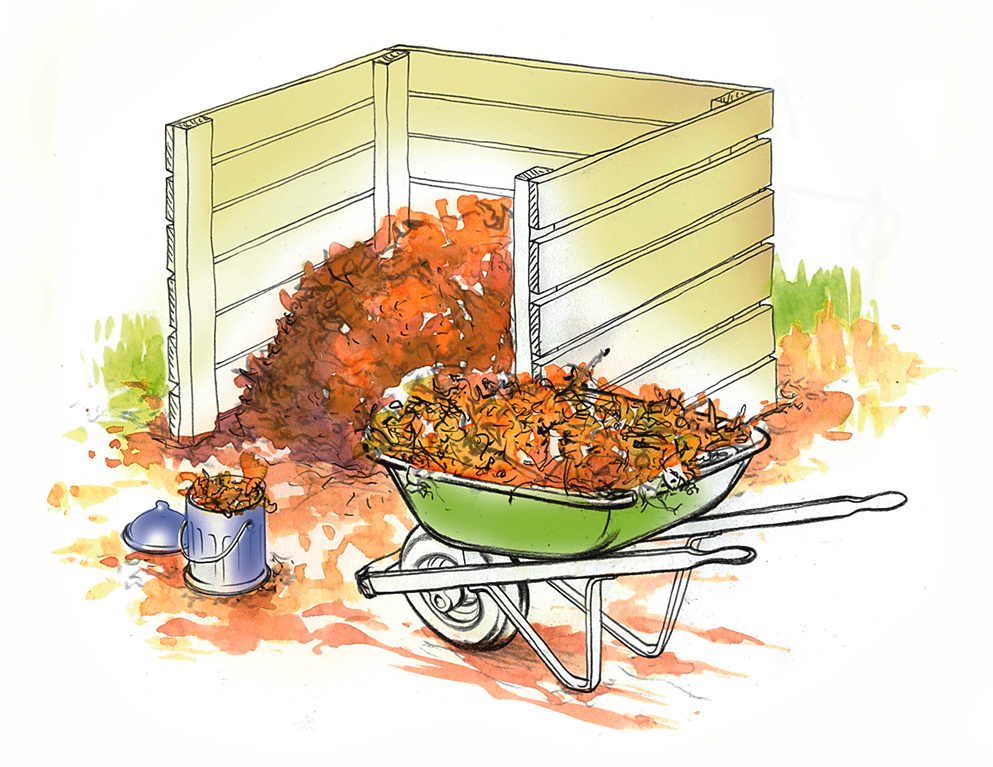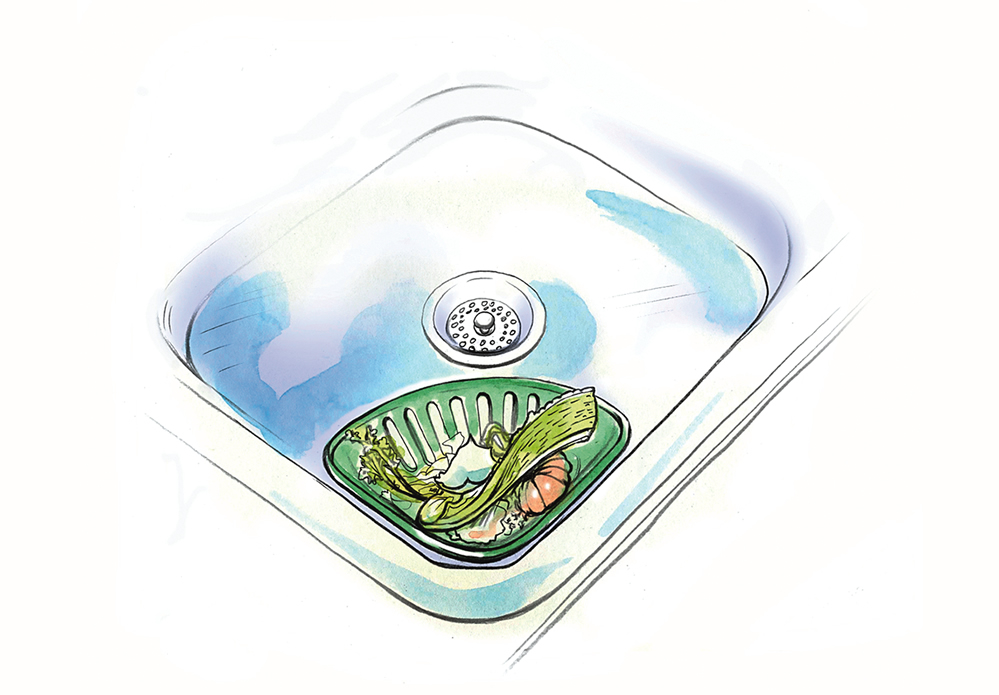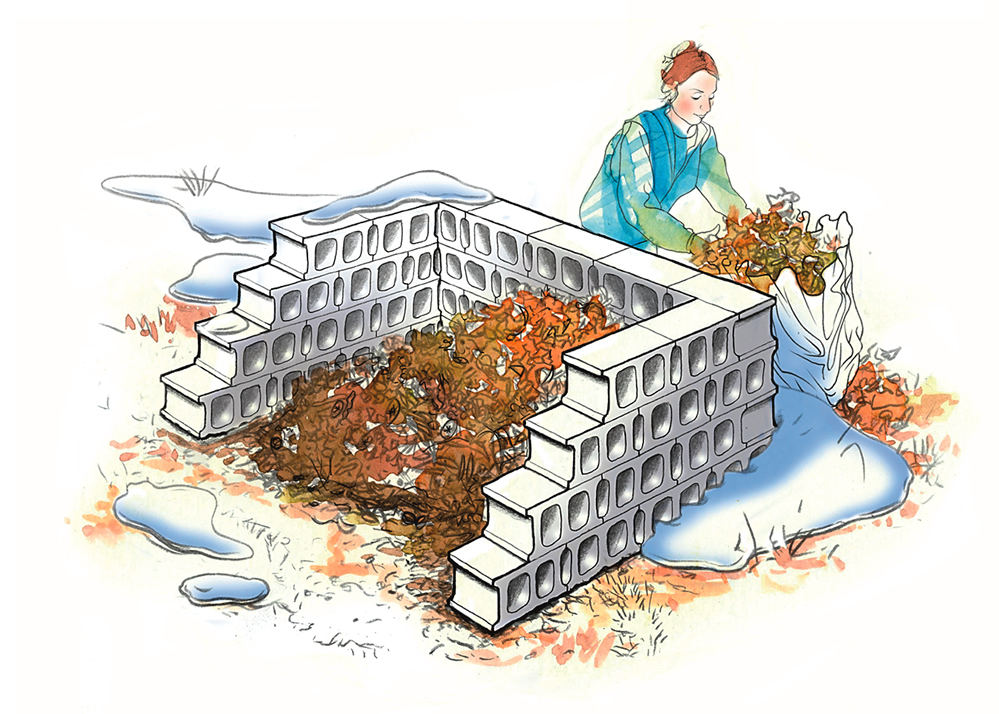Chapter 2
What Can I Compost?
Hibernian Idyll
A Scottish gardener told me one day,
“I grow food on what you throw away.”
I listened to my Hibernian host,
Now my ex-refuse is clean compost.
Ingredients for composting can be found everywhere. At home, start with kitchen scraps. Everything from fresh vegetable peelings and coffee grounds to peanut shells and stale bread make perfect additions to a compost pile. That’s just the beginning, though. A compost pile is an ideal destination for other household materials like hair (pet or human), debris from hamster or guinea pig cages, overripe fruit that didn’t make it to the table, and even newspaper. Vegetable gardens, flower borders, lawns, and shrub plantings yield even more materials, including weeds, grass clippings, leaves, spent flowers, and other garden debris.

While loads of compostables can be added to a compost pile without a second thought, consider some materials with caution and ban others altogether. This chapter presents a rundown of all the materials: what to collect, what to watch out for, and what to avoid. Information is also provided on composting materials that are available to the public and free for the asking.
1. From Kitchen to Compost Pile
In too many kitchens, mounds of food scraps are routinely tossed in the garbage or fed down the disposal where they find their way into municipal landfills and sewage or septic systems. Yet kitchen scraps typically contain 1 to 3 percent nitrogen along with calcium, phosphorus, potassium, and a host of micronutrients—all nutrients that plants need. For this reason, start a home composting operation in the kitchen with the following types of materials:
- All vegetable and fruit peelings and rinds, chopped to speed decomposition of large pieces.
- Stale or spoiled grains, bread, cereal, and other edibles, cooked or raw
- Eggshells, crushed before adding to the compost pile.
- Coffee grounds (including paper filters) and tea bags
- Leftovers, provided they don’t contain meat, fat, or bones

Handling Compost from the Kitchen
One common roadblock to composting kitchen scraps is the need to collect and empty them daily—or deal with odors, fruit flies, and the negative reactions of family members who aren’t invested in the project. Use these tips to make handling kitchen scraps as easy as possible.
Make collection simple. Keep a strainer in the kitchen sink when cooking, so it’s an easy matter to flip vegetable peelings and food waste into the compost collection. Empty the strainer daily, either by carrying it out to the compost pile or by dumping the day’s collection of kitchen scraps into a covered container on the counter or under the sink. A repurposed plastic tub with a tight-fitting lid stored under the sink makes an excellent container. To keep odors in check, don’t let compostables accumulate indoors much longer than a week when the weather’s cool or a few days in the heat of summer. Rinse the container after emptying it and let it air dry in the sun if possible. A layer of shredded newspapers or sawdust in the bottom of the bucket can help absorb moisture and odors.
Buy a container for collecting. If an ordinary plastic tub doesn’t suit, there are stylish containers with odor-tight gaskets and even charcoal filters available in stores or online. Materials range from plastic (recycled and otherwise) to crockery to stainless steel. Biodegradable plastic liner bags are available for lining containers, as well, making it easy to lift out the collected kitchen scraps and drop them—bag and all—onto the compost pile.
Use the freezer. Provided there’s space, storing compostable scraps in the freezer until they’re ready to compost will also prevent odor problems, and it’s a great way to stockpile scraps in below-freezing weather. Put scraps in plastic food bags or containers. Or purchase a classy silicone freezer bin (fuccillodesign.myshopify.com), which takes just a quick push to pop out a “compost-sicle”, leaving it clean and ready to refill.
2. Compost from Yard and Garden
While kitchen and household scraps provide a constant supply of ingredients for the compost pile, their contribution is relatively small when compared to the vast amount of material available from garden beds, lawns, and landscape plantings. From spring to fall, these outdoor sources provide the bulk of compost materials for most gardeners. Materials in the list below are ideal for making compost.
- Autumn leaves. All kinds of leaves make valuable additions to any composting operation. Shred them or run over them with a lawn mower to chop them up, speeding decomposition and helping to prevent them from sticking together into mats that resist composting.
- Garden soil. Excess soil left over from digging holes for planting or preparing garden beds is also a suitable addition to a composting operation. It adds minerals, organic matter, and microorganisms, so it acts like an activator when added to compost. Keep in mind that clay or unimproved soil does not offer any benefits and may reduce the quality of finished compost.
- Grass clippings. Fresh green grass clippings are high in nitrogen, and although mulching mowers make clippings easy (and beneficial) to leave on the lawn, grass also makes an excellent addition to any composting operation. When adding them to a pile, be sure to mix them with dried leaves, straw, or other dry materials. Otherwise, fresh grass clippings can pack down and become slimy. Dried grass clippings have less nitrogen than fresh ones, but still make an excellent addition to compost.
- Lawn grass or sod. Preparing a new garden bed commonly involves cutting up and slicing under existing lawn grass to remove it in strips and chunks. While this homemade sod can be used to repair bare spots elsewhere in the lawn, chunks of lawn grass, with soil and roots attached, make an excellent addition to compost. Place the pieces root-side up on the pile, and check periodically to make sure they dry out and die rather than root and begin to grow.
- Pine needles. These are a fine addition, but keep in mind that pine needles break down slowly. Add them sparingly and mix them with kitchen scraps or fresh weeds to hasten decomposition.
- Plant material. Add overripe, damaged, or bolted vegetables and fruit to compost piles, along with faded vase flowers and spent annuals. Deadheading flowers presents another composting opportunity. To keep the garden looking neat, pinch off spent flowers or clip stems back to the next lower leaves and add to the compost pile. Keep in mind that any seeds that have ripened may germinate in compost.
- Prunings. Trimmings from annuals, perennials, and other flowers decompose quickly in a compost pile. Chop shrub prunings into small pieces to speed decomposition. Avoid using large woody branches or run them through a chipper before composting. (See “Wood-Chip Compost” for another option for these slow decomposers.) Also avoid adding trimmings from plants showing evidence of disease, such as leaf spots, because disease organisms can be spread to other plants via compost.
- Sawdust and wood shavings. These materials are relatively slow decomposers, so add in small batches and mix them with weeds or kitchen scraps. Avoid using materials from painted or treated wood and don’t use black walnut wood, which contains a natural herbicide.
- Straw. Collect straw that has been used to mulch the vegetable garden or pathways and add it to compost. Bales of straw left over from holiday decorations also make an excellent addition to compost.
- Weeds. Pull or dig unwanted seedlings and mature weeds. But beware of weeds that are unusually drought tolerant—Asiatic dayflower (Commelina communis) is one example—as they often have enough moisture in their leaves to survive being pulled up and dumped in a compost heap. Once there, they can easily root and spread. Leave drought-tolerant weeds in a sunny spot for several days until they are thoroughly dead, before adding them to compost. Also avoid adding plants that spread via rhizomes—Canada thistles (Cirsium arvense) are a prime example. Discard these fast-spreading roots in the trash. And to prevent weeds that have gone to seed from spreading via compost, discard them in the trash as well. Or cut off and discard the seedheads and then compost the rest of the plants.
3. Proceed with Caution
Keep in mind that all compost ingredients are not created equal. Before collecting materials like grass clippings, weeds, and leaves from neighbors and friends, ask a few questions about their gardening habits. For example, do they use chemical herbicides and/or pesticides? If so, their yard wastes may contain harmful chemical residues that shouldn’t be added to compost. Use the following list to ask questions and select safe, organic compost materials:
- Hay. Not to be confused with straw, which is good, hay may contain weed seeds. Farmers often have spoiled hay—hay that has begun to decompose—available for free. Be aware that unless it was cut early before seedheads began to form, it can introduce viable seed into the compost—and from the compost into the garden. In general, avoid adding hay to the compost pile, unless the pile is a rigorously managed hot-compost pile, in which temperatures exceed 140°F to kill viable seed. (Spoiled hay makes fine mulch, but keep an eye out for weed seedlings.) Chop or shred hay before incorporating it into a pile, and combine it with fresh manure, green leaves, or grass clippings to speed decomposition and ensure that the temperature in the pile gets hot enough to kill the seeds. Finally, before buying hay, ask questions about pesticide and herbicide use. Hay from an unknown source may contain potent herbicides that can poison garden soil for years.
- Weeds. These are a double-edged sword—both good and bad. While most weeds make great compost, avoid weeds that have gone to seed or weeds with roots that spread (Canadian thistle, crabgrass, and Japanese knotweed, for example). Otherwise it is far too easy to spread these weeds throughout the garden in finished compost. Instead, send these fast-spreading weeds out with the trash, lay them in the sun to die, or burn them. Another option is to seal them in an old plastic mulch or potting soil bag (moisten weeds and attached soil if dry) and then leave it in the sun until everything inside has turned to black goo. The goo can then safely go on the compost pile.
- Wood ashes. These are very high in potassium and calcium, but use them carefully in compost. The potassium they contain washes out if they are left in the rain. Wood ashes are strongly alkaline as well, and they can create an imbalance in the nutrient balance of compost. In addition, they can increase soil salinity. Only add them to compost by dusting on very thin layers.
Because of the cons involved, think twice before adding the following materials to a compost pile:
- Activators. Provided the pile contains a healthy mix of ingredients, commercial compost activators are an unnecessary bother and expense.
- Compostable or biodegradable plastic containers and bags. Most will eventually break down in a home compost system, but it pays to test them to see before adding them in large quantities.
- Diseased plant materials. Adding plants or plant parts that have succumbed because of leaf spots, molds, or rots could spread the disease if compost conditions are not optimum. It’s generally better to send them out in the garbage or burn them.
- Dryer lint. This may contain synthetic fibers that will never decompose.
- Lime, gypsum, or bone meal. While these are all excellent soil amendments, they generally are best incorporated into soil, not mixed with compost ingredients, especially because of their effect on soil pH.
Materials to Avoid
Some things do not belong in a home compost pile. The materials listed below may attract undesirable bugs and wildlife or break down too slowly and are prone to getting smelly. Others spread weeds or diseases (plant or human), reduce the quality of the finished compost, or contain toxic chemicals.
- Bones. While tiny bits of bone are okay, generally bones also break down very slowly. They may attract unwanted visitors to the compost pile, too.
- Dog, cat, or human manure and associated pet bedding. These may all contain parasites or dangerous pathogens that are harmful to humans, particularly pregnant women, children, and people with compromised immune systems.
- Greases, fats, and oils. Again, trace amounts are okay, but these, too, break down slowly and may attract unwanted visitors.
- Gypsum board scraps. Drywall scraps may contain paint and other undesirable residues and toxins.
- Meat and fish scraps. While very small amounts are okay, usually avoid composting these materials, because they break down slowly and may attract unwanted animal visitors.
Collecting Compostables
Short on compost ingredients? Plenty of materials are available for free. Manure is a prime example of an excellent compost ingredient that is readily available from farmers. (Some farmers may offer low-cost loading or delivery, so ask!) Always ask permission before taking materials—even for leaves or grass clippings piled along curbsides waiting for pickup—and find out what pesticides and other chemicals they may contain. Use this list to get started collecting.
- Autumn leaves. Often these are pre-bagged and ready to stockpile.
- Coffee grounds. Ask at local coffee shops, and provide a bin and regular pickup.
- Discarded botanical decorations. Straw bales, cornstalks, pumpkins, spent potted chrysanthemums or poinsettias, and more
- Hair. Floor sweepings from salons, barbers, or pet groomers
- Seaweed. Coastal gardeners can gather a variety of types, and all are rich in NPK and micronutrients. Seaweed should be rinsed before adding to the compost pile to lower its salt content.
- Spent produce. Grocery stores commonly dump spent vegetables and fruits into the garbage. Again, ask and offer regular pickup.
- Spoiled livestock bedding. Hay or straw mixed with manure
- Waste products from local farms. Spent fruit, peelings, pomace, hulls, mash, and more are available at local wineries, orchards, and food processors. Local restaurants may also offer compostables.


